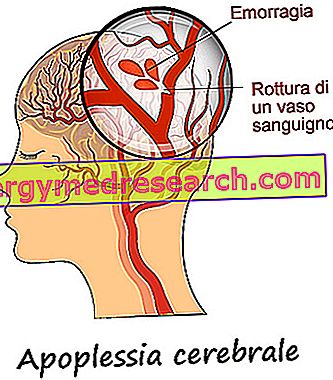Generality
The fifth disease - also known as infectious erythema or epidemic megaloeritema - is an acute infectious disease triggered by Parvovirus B19.

In the vast majority of patients, the fifth disease resolves spontaneously, without problems and without noteworthy consequences; demonstrating this is the fact that many adults affected by the fifth disease at an early age say they do not remember this infectious disease and the extent of its symptoms.
The fifth disease does not require any special treatment, as it heals spontaneously within 1-3 weeks.
The prognosis is excellent.
What is the fifth disease?
The fifth disease is an infectious disease of viral origin, with an acute and somewhat contagious course, which typically affects children of elementary school age.
Known to cause a characteristic erythema in arms, legs and cheeks, the fifth disease represents - along with rubella, measles and sixth disease - one of the main causes of virus-related rash.
What is the name of the "fifth disease"?
The fifth disease owes its name to the fact that it was, in temporal order, the fifth infectious pathology typically juvenile to be described in medicine.
Other names of the fifth disease
The fifth disease is also known with the names of: infectious erythema, epidemic megaloeritema and slapped cheek disease .
The choice of these synonyms is explained by the erythematous character of the fifth disease, including the third, in which "the slapped cheek" is a reminder of the characteristic erythema that the infectious disease in question causes at the level of the cheeks.
Epidemiology
The fifth disease is widespread all over the world and, although it can interest anyone regardless of age, it affects mainly children and young people between 5 and 15 years.
The fifth disease has a certain seasonality; in fact, with some exceptions, statistics say that most clinical cases attributable to infectious erythema are found during the winter and early spring.
Causes
"Infectious disease of viral origin" means an affection that appears due to a virus.
In the specific case of the fifth disease, the responsible virus is the so-called Parvovirus B19 .
Parvovirus B19
Discovered by chance in 1975 by the Australian virology Yvonne Cossart, Parvovirus B19 belongs to the viral family called Parvoviridae and possesses, for genome, a very small DNA molecule.

For those who were not aware of it, this tropism basically consists in the ability, on the part of Parvovirus B19, to be able to invade the not yet mature red blood cells still located inside the bone marrow.
Mode of transmission of the fifth disease
The transmission of the fifth disease (and Parvovirus B19) to a new host can take place through:
- Inhalation of infected saliva droplets, emitted by a carrier of the infection, during sneezing, coughing or when speaking.
- Contact with objects previously touched by a sick individual, followed by failure to wash hands.
- Direct contact with infected blood, clearly belonging to a sick subject.
Incubation of the fifth disease
The incubation period of the fifth disease (ie the time that must pass before the first symptoms appear after the first exposure to the pathogen) can range from a minimum of 4 to a maximum of 21 days; however, it generally lasts for 14-16 days.
When is a patient contagious to others?
An individual who has contracted the fifth disease begins to be contagious from before the onset of symptoms (ie during the incubation period of the disease) to when the first signs of skin erythema appear.
After that, the level of contagiousness diminishes fairly quickly, until it nullifies itself.
Who is most at risk?
The people most at risk of getting a fifth disease are:
- Young people between the ages of 5 and 15;
- Those who work in schools and who spend a lot of time in close contact with the young people of the age specified above (ie teachers, school collaborators, etc.);
- Parents of children and young people at risk of fifth disease (ie the "usual" young people aged between 5 and 15 years).
Symptoms and complications
Generally, the fifth disease begins with non-specific symptoms, such as low-grade fever (mild fever), headache, rhinorrhea, sore throat, tiredness and joint pain.
This symptomatology lasts a short time (2-3 days) and, when exhausted, leaves room for the most characteristic clinical manifestation of the fifth disease: the cutaneous erythema mentioned in the beginning of the article.
The cutaneous erythema of the fifth disease has very specific connotations:
- It begins at the level of the cheeks, which appear swollen and are painful, and expands, as the days go by, to other sites, such as the trunk, upper limbs, buttocks and lower limbs;
- It involves the generation of reddish spots, sometimes in relief. These reddish spots are the result of the particular predilection parvovirus B19 has towards immature red blood cells;
- On the cheeks, it is responsible for the so-called butterfly eruption, a true symptomatological peculiarity of the fifth disease;
- It rarely affects the palms of the hands and the soles of the feet;
- It tends to fade gradually. Estimates show that in about 65% of patients it disappears within 5-8 days, while in the remaining 35% of clinical cases it resolves within 2-3 weeks.
Sometimes, it may happen that, together with skin erythema, an oral rash (characterized by small pink spots on the palate and pharyngeal mucosa) and occipital or latero-cervical adenopathies arise.
Still in any circumstances it may happen that with the erythema the joint pains also arise, referred to when talking about the onset symptomatology of the fifth disease (it is therefore possible that the joint pain appears at a later time).
Fifth disease in children and adults
In adults, the fifth disease produces symptoms that are only partially comparable to those of children.
In fact, while in young patients the presence of the cutaneous erythema described above is predominant compared to other disorders, in adult patients the pain in the joints is better reflected (in particular in those of the wrists, knees, ankles, fingers and shoulders) ).
Curiosity: How is joint pain manifested in young people and adults with fifth disease?
In adult patients, joint pain can occur in a variety of ways: in the form of acute arthritis (at least 60% of cases), subacute arthritis, chronic arthritis and arthromial pain (20% of cases) accompanied or not by a sense of chronic fatigue.
In children, on the other hand, joint pain usually presents as arthromial pain and, more rarely, in the form of arthrosynovitis.
Complications of the fifth disease
The fifth disease is an infectious disease of modest clinical entity, which, however, in specific groups of people, can degenerate into serious complications.
Among the subjects particularly sensitive or susceptible to the fifth disease, there are:
- Individuals suffering from autoimmune hemolytic anemia, alpha / beta thalassemia, chronic myeloid leukemia, hemolytic anemia due to pyruvate kinase deficiency and sickle cell anemia .
- In this wide range of sensitive subjects, the fifth disease can have various consequences, including: acute anemia, consistent decrease in red blood cells, disappearance of reticulocytes (aplastic crisis) and leukopenia.
- Pregnant women in the first trimester of pregnancy. In these subjects, the fifth disease can cause fetal hydrops, significantly increasing the risk of miscarriage.
- Individuals in a state of immunodepression, due for example to a disease such as ADIS or to taking chemotherapy drugs.
Diagnosis
The diagnosis of the fifth disease is based, in general, on the simple evaluation and critical analysis of the symptoms and signs, therefore, essentially, on the physical examination and on the anamnesis.
This is possible because the fifth disease - as stated on more than one occasion - causes a characteristic erythema.
How to diagnose the fifth disease in the absence of the characteristic erythema?
The diagnosis of the fifth disease can be difficult to put, in the case in which the infectious disease in question is limited to cause non-specific symptoms, without causing the classic erythema on the cheeks or on other parts of the body.
To resolve the doubts and perplexities that inevitably emerge from these circumstances, it is sufficient that the doctor prescribes a series of blood tests to the patient, which allow the precise causal agent to be established once and for all.
Curiosity
In the absence of a clear and evident symptomatology, the fifth disease can be confused with measles, rubella, the fourth disease or scarlet fever.
This eventuality justifies the strategy of differential diagnosis, based on more thorough examinations of what is the simple analysis of symptoms.
Therapy
Generally, the fifth disease does not require any particular therapy, as it tends to resolve spontaneously, without however having any minimal consequence on the patient.
Sometimes, if the fever is persistent and / or the joint pain is intense, it may happen that the attending physician prescribes an antipyretic such as paracetamol, which is easy to use and sufficiently effective against the aforementioned symptoms.
Clearly, during the course of the disease, the patient must be at absolute rest from any activity (school, work, etc.), so as to facilitate healing; moreover, it is good that it takes a lot of water, since a correct hydration keeps the functions of the organism efficient (and this is fundamental, when a defensive action is in progress against an infection).
See also: Fifth Disease Medications »
Important note: avoid solar radiation
The skin erythema that characterizes the fifth disease requires patients to avoid exposure to solar radiation, as these are potential responsible for an aggravation of skin symptoms.
Prognosis
The prognosis in case of fifth disease is generally excellent. Complications, in fact, are rare and concern particular categories of people.
What are the healing times?
The healing time from the fifth illness can vary from one to three weeks .
How long can a child return to school?
A child could go back to school and get in touch with other people once the rash appears. As stated, in fact, the appearance of skin erythema coincides with the end of the patient's contagiousness.
Nevertheless, doctors advise you to wait a few days to avoid unnecessary fatigue.
Can anyone who gets the fifth disease get sick again?
The fifth disease produces a definitive natural immunity; in other words, following the parvovirus B19 infection, the human being is able to develop a natural protection against the aforementioned virus, which denies any possibility of falling ill again with the fifth disease.
Prevention
Currently, there is no vaccine aimed at preventing the fifth disease and, given the extent of the infection in question, there is not even the need.
How to reduce the risk of infection?
To reduce the risk of infection, doctors recommend those with fifth disease and those who take care of them, frequent and thorough hand washing.
Fifth Disease in brief: summary of the fifth disease »



